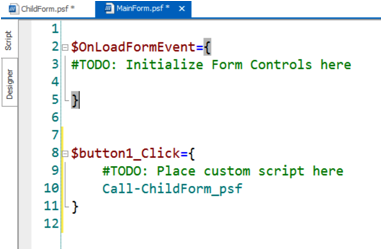
- #Sapien powershell studio import file install#
- #Sapien powershell studio import file code#
- #Sapien powershell studio import file windows 7#
The default is true for accessibility purposes.īe aware this setting will prevent the focus from changing to the console, even when you use a command that explicitly calls for input, like Get-Credential. To keep the focus in the editor when you execute with F8 change the following setting: "": false
#Sapien powershell studio import file code#
In this case, the default behavior of the code editor may feel strange to you. Open-EditorFile ExportData.ps1, ImportData.pyįor those users who are used to working with SSMS, you're used to being able to execute a query, and then being able to re-execute it again without having to switch back to the query pane.

To open one or more files in Azure Data Studio, use the Open-EditorFile command. This command works for any file type, not just PowerShell files. PS C:\temp> New-EditorFile ExportData.ps1 To create and open a new file inside the editor, use the New-EditorFile from within the PowerShell Integrated Terminal. To open/view the extension's examples in Azure Data Studio, run the following code from your PowerShell command prompt: azuredatastudio (Get-ChildItem $Home\.azuredatastudio\extensions\microsoft.powershell-*\examples) Or if you're using the preview version of the extension $HOME/.azuredatastudio/extensions/microsoft.powershell-preview-/examples This folder can be found at the following path: $HOME/.azuredatastudio/extensions/microsoft.powershell-/examples Check out the included README.md file to learn more about Use to discover PowerShell editing and debugging functionality. There are some example scripts in the extension's examples folder that you can PowerShell Core is an Open Source project on GitHub.įor more information on installing PowerShell Core on macOS or Linux platforms, see the following articles:
#Sapien powershell studio import file install#
If you are running Azure Data Studio on macOS or Linux, you may also need to install PowerShell Core. Read the FAQ for answers to common questions.
#Sapien powershell studio import file windows 7#
Windows 7 through 10 with Windows PowerShell v3 and higher, and PowerShell Core.You can also install a VSIX package from our Releases page and install it through the command line: azuredatastudio -install-extension PowerShell-.vsix Get notified automatically about any future extension updates! In the Extensions pane, search for "PowerShell" extension and install it there. You can install the official release of the PowerShell extension by following the steps Launch online help for the symbol under the cursor using Ctrl+ F1.Run selected selection of PowerShell code using F8.Document and workspace symbol discovery.Find References of cmdlets and variables.Go to Definition of cmdlets and variables.Rule-based analysis provided by PowerShell Script Analyzer.Now you can write and debug PowerShell scripts using the excellent IDE-like interface that Azure Data Studio provides.

Under the “ Deployment” section, basically we can use it to collect all the script files and store documentation to be deploy somewhere on the network or media device.This extension provides rich PowerShell editor support in Azure Data Studio. Now, we have created the GUI application MSI installer which can be distributed to other machines.

“ Signing” – (optional) Only if you want to sign your application solution with your signed certificate.Īfter everything under setting has been configured, proceed to “ Build” the installer. You can add more resource file with it.Ĥ. “ Files/ Folder” – This section will set where your MSI files will be stored. Notice you can chose any PowerShell version available.ģ. Under “ Product Details” – Describes your application in details. “ Deploy | Installer” – “ Settings” – To enter all the information needed about this GUI application.Ģ. The flow to build your MSI installer would be:ġ. In our previous blog we build a GUI application and created the executable file using either the “ Build” or “ Build & Run” option under the “ Deploy | Packager” section.Īlthough, this is optional, we could have created an MSI installer which will produce all the necessary steps to deploy the GUI application.


 0 kommentar(er)
0 kommentar(er)
